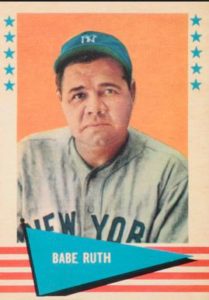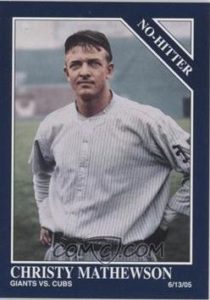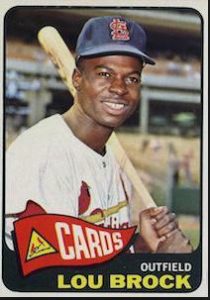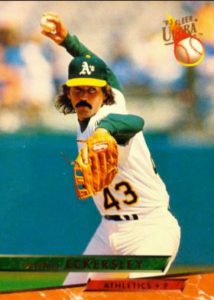Well, sadly, the baseball seasons is over – congratulations Astros! We will soon be in the trading season (we are already in the speculation season). With that in mind, Baseball Roundtable would like to dedicate this post to what BBRT sees as the half dozen worst MLB trades of all time (or, if you look at it from the other side, the six best). Surprisingly (or maybe not), five of the six involved future Hall of Famers.
- Babe Ruth from the Red Sox to the Yankees (January 1920) – for $125,000 and a $300,000 loan (reportedly to fund a Broadway show)
 Okay, so technically this was a sale and not a trade. It’s still has to be here as the worst front-office move ever.
Okay, so technically this was a sale and not a trade. It’s still has to be here as the worst front-office move ever.
The Red Sox were moving a player who had gone 89-46 with a 2.19 ERA over six seasons in Boston. As a pitcher, Ruth was a two-time twenty-plus game winner and had led the AL in ERA, games started, complete games and shutouts once each. Not only that, he had led the American League in home runs in his last two seasons (1918-19) with the Red Sox; while going 22-12 on the mound. His last year with Boston, Ruth hit .322 and led the AL in runs (103), RBI (113) and set a new single-season home run record (29). The final straw? Ruth was just 25-years-old.
The Red Sox sale ranks at the top because it involved the “biggest name” in the game – and the Red Sox were fully aware of what they had (and what they were giving up) and received no on-the field return.
In Ruth’s first season as a Yankee (1920), he hit .376 and obliterated his own single-season HR record with 54 long balls – out-homering every other team in the AL (the Red Sox logged 22 round trippers without Ruth) and all but one team in the NL. That season, Ruth also led the AL in runs (158); RBI (135); and walks (150).
For their $125,000, the Yankees ended up getting 15 seasons of “Ruthian” production – a .349 average, 659 (of his 714) home runs, 1,978 RBI. During his NY tenure, the Babe won ten home run titles, four times led the league in RBI, seven times topped the AL in runs scored and picked up the 1923 MVP Award. Ruth was inducted into the Baseball Hall of Fame as part of the 1936 inaugural class. As the number-one bad front-office move, this one’s a no-doubter.
_________________________________________________________________________________
- Christy Mathewson from the Reds to the Giants (December 1990) … for Amos Rusie
 Christy Mathewson got off to an unusual start – and was almost the Giants’ Hall of Famer that got away. In 1900, as a 19-year-old, Mathewson was tearing up the Class D Virginia-Carolina League running up a 20-2 record by mid-July. The New York Giants noticed, signing him and bringing the teenager up to the big club. For the Giants, Mathewson went 0-3, with a 5.08 ERA – leading the New York club to send him back to Norfolk (asking for their money back). The Reds picked up Mathewson in the off season for $100 and – here comes the trade – sent him back to the Giants for veteran hurler Amos Rusie. The rest, as they say, is history.
Christy Mathewson got off to an unusual start – and was almost the Giants’ Hall of Famer that got away. In 1900, as a 19-year-old, Mathewson was tearing up the Class D Virginia-Carolina League running up a 20-2 record by mid-July. The New York Giants noticed, signing him and bringing the teenager up to the big club. For the Giants, Mathewson went 0-3, with a 5.08 ERA – leading the New York club to send him back to Norfolk (asking for their money back). The Reds picked up Mathewson in the off season for $100 and – here comes the trade – sent him back to the Giants for veteran hurler Amos Rusie. The rest, as they say, is history.
Mathewson pitched 16 more seasons for the Giants and ended up winning 372 games (188 losses) with a 2.13 ERA for New York. (He added one win, ironically, for the Reds in his last season (1916). Mathewson won 20 or more games in a season 13 times (30+ four times), led the league in ERA five times, in strikeouts five times and in shutouts four times. The Big six was inducted into the Baseball Hall of Fame in 1936.
The Christy Mathewson for Amos Rusie trade ranks right up there with the Babe Ruth sale. After all, Mathewson won 372 games for his new team, while Rusie went 0-1, 8.59 for his career after the trade (he had 246 MLB wins before the transaction). The Ruth trade gets an edge because, the move came at a time when The Babe was “peaking,” while the Mathewson/Rusie deal involved a player with potential for one the down side of a Hall of Fame career.
What did the Reds get in return? Rusie – known as The Hoosier Thunderbolt – was a nine-season MLB veteran with 246 MLB wins (174 losses) under his belt at the time of the trade. He had won 20 or more games in all seven of his seasons with the Giants (30+ four times), had led the NL in strikeouts five times and would eventually be elected to the Hall of Fame. However, Rusie (who had suffered an arm injury in 1898) had been out of baseball for two years. Attempting a comeback, he pitched just three games for Cincinnati – going 0-1, 8.59 – before retiring. Overall, the Giants came out 372 wins to the good on this transaction – number-two on BBRT’s worse trade list.
__________________________________________________________________
- Nolan Ryan from the Mets to Angels (December 1971) – for Jim Fregosi
 Okay, so maybe the Mets didn’t know what they had in Ryan. After all, he was 10-14, 3.97 the year before the trade – and Fregosi was a six-time All Star shortstop. Still, Fregosi was coming off a season when he had hit just .233-5-33 in 107 games. What adds insult to injury on this move is that – in order to get Fregosi – the Mets also sent the Angels pitching prospect Don Rose, catcher Frank Estrada, as well as outfielder Leroy Stanton. (Rose went 1-4, 4.22 for the Angels in 1972 and 1-4, 4.14 in three MLB seasons; Estrada had two major league at bats with the Mets in 1971 and never played in the majors again, and Stanton played five seasons for the Angels – hitting .247, with 47 home runs, 242 RBI and 35 stolen bases, numbers which exceeded Fregosi’s production for the Mets.)
Okay, so maybe the Mets didn’t know what they had in Ryan. After all, he was 10-14, 3.97 the year before the trade – and Fregosi was a six-time All Star shortstop. Still, Fregosi was coming off a season when he had hit just .233-5-33 in 107 games. What adds insult to injury on this move is that – in order to get Fregosi – the Mets also sent the Angels pitching prospect Don Rose, catcher Frank Estrada, as well as outfielder Leroy Stanton. (Rose went 1-4, 4.22 for the Angels in 1972 and 1-4, 4.14 in three MLB seasons; Estrada had two major league at bats with the Mets in 1971 and never played in the majors again, and Stanton played five seasons for the Angels – hitting .247, with 47 home runs, 242 RBI and 35 stolen bases, numbers which exceeded Fregosi’s production for the Mets.)
Nolan Ryan had zero All Star selections before the trade and eight after the trade. Jim Fregosi was a six-time All Star before the trade and did not make another All Star squad.
Ryan, who had gone 29-38, 3.58 in five Mets’ seasons, blossomed with the Angels. In his first year in California (1972), he was an AL All Star – going 19-16, 2.28 and leading the league in strikeouts with 329 and shutouts with nine. He spent eight seasons with the Angels, and was a five-time All Star and two-time 20-game winner during that period. He logged 138 of his ultimate 324 MLB wins in an Angels’ uniform. (His line with the Angels was 138-121, 3.07.) He also led the AL in strikeouts seven times in his eight Angels’ seasons, topping 300 whiffs five times. Ryan notched 2,416 of his MLB-record 5,714 strikeouts and four of his record seven no-hitters as an Angel. He achieved free agency after the 1979 season and left the Angels for the Astros. But clearly, the Halos got plenty of mileage out of this ultimately Hall of Famer (inducted 1999) after the Fregosi trade.
How did the Mets’ fare? Fregosi faced some injury issues and, in his first year as a Met (primarily playing 3B), hit .232-5-32 in 101 games – remarkably similar to his previous season with the Angels. He was on the same track in 1973, hitting .234-0-11 in 45 Mets’ contests before being sold to the Rangers on July 11 of that season. Fregosi finished an 18-season MLB career in 1978 with a career .265 average, 151 home runs and 706 RBI.
________________________________________________________________________
- Lou Brock (along with Jack Spring and Paul Toth) from the Cubs to the Cardinals (June 1964) – for Ernie Broglio, Bobby Shantz and Doug Clemens
 First a look at the two principal in the trade – Lou Brock and Ernie Broglio.
First a look at the two principal in the trade – Lou Brock and Ernie Broglio.
The 25-year-old Brock was in his fourth season with the Cubs at the time of the trade – and was hitting .251, with two home runs, 14 RBI and ten stolen bases (52 games). The previous year, he appeared to have broken out, going .315-14-58 (with 43 steals for the Cubs). Still his .251 average seemed more in line with his .263 and .258 averages in his first two Cubs’ campaigns.
Broglio was a veteran pitcher – at age 28, in his sixth major league season. He had been a 21-game winner in 1960 and an 18-game winner the season before the trade (18-8, 2.99 for the Cardinals in 1963). At the time of the trade, he was 3-5, 3.50 in 11 starts.
Brock went on to play 16 seasons (including 1964) with the Cardinals, hitting a healthy .297, with 149 home runs and 900 RBI. He also swiped 938 bases – leading the league in steals eight times, with a high of 118 in 1974. He was a six-time All Star for Saint Louis and was inducted into the Baseball Hall of Fame in 1985. Broglio was with the Cubs until 1966, winning just seven games (losing 19) with a 5.40 ERA. Clearly, advantage Cardinals.
In 1968, 29-year-old Lou Brock in the fifth of 16 seasons with the Cardinals, led the NL with 46 doubles, 14 triples and 62 stolen bases. In 1968, 32-year-old Ernie Broglio was out of the major league. Following the trade for Brock, he won just seven more MLB games (19 losses).
But what about the others in the trade?
Going with Brock to the Cardinals were southpaw Jack Spring (a journeyman who had started the season with the Angels and was 0-0, 6.00 with the Cubs) and RHP Paul Toth (in his third, and final MLB season), who was 0-2, 8.44 at the time of the trade. Spring pitched in just two games for the Cardinals in 1963 (three innings). His final MLB season was 1965 (1-2, 3.74 for the Indians) – and he was 12-5, 3.74 for seven teams in eight MLB seasons. Toth did not pitch in the majors again after the trade and finished his MLB career at 9-12, 3.80 in three seasons.
Along with Broglio, the Cardinals sent veteran (38-year-old) southpaw Bobby Shantz – a former MVP, for the Philadelphia Athletics in 1952. Shantz was winding down his career as a reliever and was 1-3, 3.12 at the time of the transaction. Also included in the deal was outfielder Doug Clemens hitting .205-1-9 at the time of the deal. Shantz went 0-1, 5.56 for the Cubs (20 games) before being sold to the Phillies in mid-August. He went 1-1, 2.25 for the Phillies and retired after the 1964 season. Clemens did pay some dividends. After the trade, he hit .279, with two home runs and 12 RBI in 54 games for the Cubs. He then hit .221-4-26 in 128 games in 1965. He was traded to the Phillies for Wes Covington before the 1966 season. Covington got in just nine games for the Cubs before he was released. Clearly, this was a “Two-B” trade – Brock for Broglio – and if the Cubs had seen what was to be, they would probably have hung on to Brock.
____________________________________________________________________
- Dennis Eckersley from the Cubs to the A’s (April 1987) – for David Wilder, Brian Guinn, Mark Leonette
 This was a trade that was made to look awfully good, thanks to the insight of the coaching staff. After the 1986 season, the future of the 31-year-old Eckersley seemed questionable. In 1986, the former 20-game winner (20-8, 1978) – in his twelfth MLB season and third season with the Cubs – faced a bout with shoulder tendinitis and put up a disappointing 6-11 record, with a 4.67 ERA. The Cubs showed little patience, but perhaps they should have. Eckersley’s career MLB record at the time was 151-128, 3.67 (376 games/359 starts) and he’d been a respectable 11-7, 3.08 in 1985. Even in 1986, he had pitched 200+ innings, given up the fewest walks per nine innings among NL starters and put up a 3.19 strikeouts-to-walks ratio. Regardless, Eckersley was sent off to Oakland in a trade for three minor leaguers: outfielder Dave Wilder (who hit .301 at AA in 1986); SS/2B Brian Guinn (.277-5-64 at AA/AAA in 1986); and RHP Mark Leonette (6-4, 3.78 at AA in 1986). The return on “Eck” wasn’t exactly overwhelming – none of the three ever played in the major leagues.
This was a trade that was made to look awfully good, thanks to the insight of the coaching staff. After the 1986 season, the future of the 31-year-old Eckersley seemed questionable. In 1986, the former 20-game winner (20-8, 1978) – in his twelfth MLB season and third season with the Cubs – faced a bout with shoulder tendinitis and put up a disappointing 6-11 record, with a 4.67 ERA. The Cubs showed little patience, but perhaps they should have. Eckersley’s career MLB record at the time was 151-128, 3.67 (376 games/359 starts) and he’d been a respectable 11-7, 3.08 in 1985. Even in 1986, he had pitched 200+ innings, given up the fewest walks per nine innings among NL starters and put up a 3.19 strikeouts-to-walks ratio. Regardless, Eckersley was sent off to Oakland in a trade for three minor leaguers: outfielder Dave Wilder (who hit .301 at AA in 1986); SS/2B Brian Guinn (.277-5-64 at AA/AAA in 1986); and RHP Mark Leonette (6-4, 3.78 at AA in 1986). The return on “Eck” wasn’t exactly overwhelming – none of the three ever played in the major leagues.
Initially, Eckersley’s role in Oakland was not overly promising. He was relegated to the bullpen, although he did get two starts in May – pitching 11 2/3 innings, giving up nine runs and taking two losses. Then, an arm injury to Oakland’s Jay Howell left an opening for a closer – and the A’s staff saw potential in the Eckersley combination of grit and control. They moved him into the closer’s role – and Eckersley’s career we revitalized at age 32. Eckersley saved 16 games in the last half of 1987 – and never looked back. He led the AL in saves with 45 in 1988.
Dennis Eckersley’s 320 saves gave Oakland a pretty good return on three minor leaguers who did not play in the majors.
Eckersely pitched for the A’s from 1987 through 1995, notching 320 saves, a 2.74 ERA and 658 strikeouts (versus just 92 walks) in 637 innings. He was an All Star four times with Oakland. In 1992, he went 7-1, with a league-leading 51 saves and a 1.91 ERA – winning both the Cy Young Award and AL MVP honors. In February of 1996, the A’s traded Eckersley to the Cardinals for reliever Steve Montgomery – a bad trade of their own, since Montgomery pitched in just 12 games for the A’s (1996-97), going 1-1 with an ERA north of 9.00, while Eckersley saved 66 games in the next two seasons for the Cardinals
Eckersley retired in 1998, with a career record of 197-171, with 390 saves and a 3.50 ERA. That earned him induction into the Baseball Hall of Fame (2004).
____________________________________________________________________
- George Foster from the Giants to the Reds (May 1971) – for Frank Duffy and Vern Geishert
 Here’s a trade the paid great dividends, thanks in part to the patience of the Cincinnati Reds’ organization.
Here’s a trade the paid great dividends, thanks in part to the patience of the Cincinnati Reds’ organization.
George Foster came up with the Giants for the proverbial “cup of coffee” in 1969 (as a 20-year-old) and 1971 – getting into 18 games and hitting .333, with one home run and four RBI. (In 1970, he was .308-8-66 in 114 games as Triple A.) Foster started slowly for the Giants in 1971 – hitting .267, with three home runs and eight RBI in 36 games before being traded to the Reds in May. In 104 games for the Reds that season, he hit .234 with 10 home runs, 50 RBI and seven steals. In 1972, Foster played just 59 games for the Reds – going .200-2-12. He split the following year between Cincinnati and the Triple A Indianapolis Indians – where he started to show a little pop (15 home runs in 134 games at AAA). In 1974, Foster was still developing, going .264-7-41 in 106 games for the Reds. It was in 1975 that the patience of the Reds – and this trade – began to pay off. From 1975-81, Foster was an All Star five times, hitting .297, with 221 home runs and 749 RBI over that span. In those seven seasons, he led the league in home runs twice (a high of 52 in 1977), RBI three times and runs scored once. He was an integral part of the Big Red Machine – and won the NL MVP Award in 1977 (.320-52-149).
Hard to fault the Giants for not seeing Foster’s full potential. He didn’t make his first All Star team until his sixth season with the Reds. From 1971-74, Foster’s first four campiagns with the Reds, he played in 286 games for Cincinnati, hitting .247, with 23 home runs and 143 RBI. In 1977 alone, he topped his 1971-74 Reds’ totals in hits, runs scored, home runs and RBI. (1971: .320-59-149, with 197 hits and 124 runs scored.)
The return for the Giants? Frank Duffy had just 19 games in the MLB (for the Reds) at the time of the trade, with a .185 average. He played in just 21 games for the Giants in 1971, hitting 179. After the season, Duffy was part of another major trade, getting sent to the Indians (along with Gaylord Perry) for veteran pitcher Sam McDowell. McDowell pitched part of two season for the Giants, going 11-10, 4.36. Geishert was a right-headed pitcher who had seen action for the Angels in 11 games in 1969 (1-1. 4.65). He did not appear in the major leagues again. Side note: Duffy actually went on to a ten-year MLB career (six years with the Indians) as a slick-fielding shortstop (he hit just .232 in 915 MLB games)
Primary resources: Society for American Baseball Research; Baseball-Almanac.com; Baseball-Reference.com
I tweet baseball @DavidBBRT
Follow/Like the Baseball Roundtable Facebook page here. More baseball commentary, blog post notifications and prizes. (Next week, BBRT is giving away Clemens and Torre bobbleheads.
Member: Society for American Baseball Research (SABR); The Baseball Reliquary; The Negro Leagues Baseball Museum





